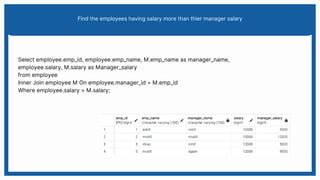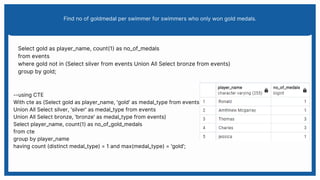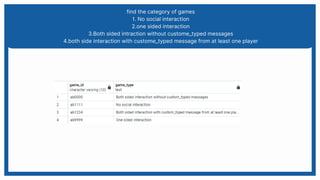IMPORTAnt sql ques for data analyst interview.pdf
- 2. Find the employees having salary more than thier manager salary Select employee.emp_id, employee.emp_name, M.emp_name as manager_name, employee.salary, M.salary as Manager_salary from employee Inner Join employee M On employee.manager_id = M.emp_id Where employee.salary > M.salary;
- 3. Find the employee with second highest salary from each department Select * from (select emp.*, dense_rank() Over(Partition By department_id Order By salary Desc ) as rn from emp) a where rn= 2;
- 4. find employees who are not present in the depratment table Select emp.*, dept.dept_id, dept.dept_name from emp Left Join dept On emp.department_id = dept.dept_id where dept.dept_id is Null;
- 5. How to find the mode --Method 1 With Freq_cte as( Select id, count(*) as freq from mode group By id) Select * from freq_cte where freq = (select Max(freq) from Freq_cte); --Method 2 With Freq_cte as( Select id, count(*) as freq from mode group By id), rnk_cte as( Select *, rank() over(order By freq desc) as rn from Freq_cte) Select * from rnk_cte where rn = 1
- 6. SELECT e20.*, e21.*, CASE WHEN e20.designation IS DISTINCT FROM e21.designation THEN 'Promoted' WHEN e21.designation IS NULL THEN 'Resigned' ELSE 'New' END AS comment FROM emp_2020 e20 FULL OUTER JOIN emp_2021 e21 ON e20.emp_id = e21.emp_id WHERE COALESCE(e20.designation, 'XXX') != COALESCE(e21.designation, 'YYY'); find the change in employee status from 2020 to 2021 -> Example of full outer join
- 7. With cte_dup as( Select id from list group by id Having count(1)>1), cte_rank as( select id, rank() Over(order by id asc) as rn from cte_dup) select l.id, 'DUP' || cast(cr.rn as varchar(2)) as output from list l Left Join cte_rank cr On l.id = cr.id Rank the duplicate records
- 8. Select *, sum(cost) Over(order by cost asc, product_id) as running_cost from product; find the running sum
- 9. --method1 create table empl_backUp as Select * from empl; Delete from empl; Insert Into empl Select distinct * from empl_backUP; Select * from empl Identify and delete excat duplicate record --method2 Insert Into empl select id,name, salary, joining_date from (Select *, row_number() Over(partition by id order by salary) as rn from empl_backUP ) A where rn =1;
- 10. with cte as( Select Customer_Name,region, sum(sales) as total_Sales from Order_A group by Customer_Name, region Order By region, total_sales desc Limit 18) Select * from (Select * , NTILE(4) Over (Partition By region Order by total_Sales) as cust_groups from cte) a where cust_groups IN(1) NTILE function
- 11. Select gold as player_name, count(1) as no_of_medals from events where gold not in (Select silver from events Union All Select bronze from events) group by gold; Find no of goldmedal per swimmer for swimmers who only won gold medals.
- 12. Select gold as player_name, count(1) as no_of_medals from events where gold not in (Select silver from events Union All Select bronze from events) group by gold; Find no of goldmedal per swimmer for swimmers who only won gold medals. --using CTE With cte as (Select gold as player_name, 'gold' as medal_type from events Union All Select silver, 'silver' as medal_type from events Union All Select bronze, 'bronze' as medal_type from events) Select player_name, count(1) as no_of_gold_medals from cte group by player_name having count (distinct medal_type) = 1 and max(medal_type) = 'gold';
- 13. SELECT t.ticket_id, t.create_date, t.resolved_date, COUNT(*) AS business_days FROM tickets t JOIN generate_series(t.create_date, t.resolved_date, interval '1 day') AS dates ON EXTRACT(ISODOW FROM dates) < 6 -- Exclude Saturday (6) and Sunday (7) LEFT JOIN holidays h ON dates = h.holiday_date WHERE h.holiday_date IS NULL GROUP BY t.ticket_id, t.create_date, t.resolved_date; find business days between create days and resolved days excluding weekends and public holidays
- 14. --method1 with cte as( select emp_id, max(case when action='in' then time end) as intime, max(case when action = 'out' then time end) as outtime from hospital group by emp_id) Select * from cte where intime > outtime or outtime is null find the total no of people present inside the hospital --method 2 with latest_time as( select emp_id, max(time) as max_latest_time from hospital group by emp_id), latest_in_time as (select emp_id, max(time) as max_in_time from hospital where action = 'in' group by emp_id) select * from latest_time lt inner Join latest_in_time lit on lt.emp_id=lit.emp_id and max_latest_time = max_in_time;
- 15. with sal_dep as ( select dept_id, salary from emp_salary group by dept_id, salary having count(1)>1) Select es.* from emp_salary es inner join sal_dep sd ON es.dept_id= sd.dept_id and es.salary = sd.salary return all employees whose salary same in same department -- left join method 2 with sal_dep as ( select dept_id, salary from emp_salary group by dept_id, salary having count(1)=1) Select es.* from emp_salary es left join sal_dep sd ON es.dept_id= sd.dept_id and es.salary = sd.salary where sd.dept_id is null
- 16. SELECT word, COUNT(*) AS cnt_of_words FROM ( SELECT regexp_split_to_table(content, ' ') AS word FROM namaste_python ) AS split_words GROUP BY word HAVING COUNT(*) > 1 ORDER BY cnt_of_words desc; find the words whicch are repeating more than once considering all the rows of content column
- 17. with cte as( select m.genre, m.title, round(avg(r.rating),0) as avg_rating, row_number() over(partition by m.genre order by avg(r.rating) desc) as rn from movies m inner join reviews r On m.id = r.movie_id group by m.genre, m.title order by m.genre, avg_rating desc) select genre, title, avg_rating , Repeat('*',avg_rating::int) as stars from cte where rn = 1 find, within each genre, the movie which have highest average rating and also print the star *****
- 18. --approach1 with cte as( select dep_id, max(salary) as max_salary, min(salary) as min_salary from employee1 group by dep_id) select e.dep_id, max(case when salary = max_salary then emp_name else null end )as max_sal_emp, min(case when salary = min_salary then emp_name else null end )as min_sal_emp from employee1 e inner join cte On e.dep_id = cte.dep_id group by e.dep_id; write the query to find the highest and lowest salary employee in each department --approach2 with cte as( select *, rank() over(partition by dep_id order by salary desc) as rank_desc, rank() over(partition by dep_id order by salary asc) as rank_asc from employee1) select dep_id, max(case when rank_desc = 1 then emp_name end) as max_sal_emp ,min(case when rank_asc = 1 then emp_name end )as min_sal_emp from cte group by dep_id
- 19. --method1 Select coalesce(s.id,t.id) as id, -- s.name,t.name case when t.name is null then 'new in source' when s.name is null then 'new in target' else 'mismatched' end as comment from source s full outer join target t On s.id = t.id where s.name != t.name or s.name is null or t.name is null find the names which are not common in both source and target table. --method2 with cte as( select *, 'source' as table_name from source union all select *, 'target' as table_name from target ) select id, case when min(name) != max(name) then 'mismatched' when min(table_name)= 'source' then 'new in source' when max(table_name) = 'target' then 'new in target' end as comment from cte group by id having count(*) =1 or( count(*) = 2 and min(name) != max(name))
- 20. select o.cid, o.origin, o.destination as final_destination from flights o inner join flights d On o.destination = d.origin find the original and final destination for each flight
- 21. Select order_date, count(distinct customer) as count_new_cust from( select *, rank() over(partition by customer order by order_date) as rn from sales) a where rn = 1 group by order_date find the count of new customer in each month
- 22. -- approach 1 select r.c_id, p.name as child_name, max(m.name) as mother_name, max(f.name) as father_name from relations r left join people m on r.p_id = m.id and m.gender = 'F' left join people f on r.p_id = f.id and f.gender = 'M' inner join people p On p.id = r.c_id group by r.c_id, p.name find the father's name and mother's name of every child --approach 2 select r.c_id as child_id, p.name as child_name, max(case when p.gender = 'F' then name end) as mother_name, max(case when p.gender = 'M' then name end) as father_name from relations r inner join people p on r.p_id=p.id group by 1, p.name
- 23. --appraoch2 with cte as( select *, revenue - lag(revenue,1,0) over(partition by company order by year) as rev_diff from company_revenue ) select company from cte where company not in (select company from cte where rev_diff < 0) group by company find the compnies which revenue is icreasing (no dip) --approach1 with cte as( select *, revenue - lag(revenue,1,0) over(partition by company order by year) as rev_diff, count(1) over(partition by company) as cnt from company_revenue ) select company, cnt, count(1) as sales_inc_year from cte where rev_diff > 0 group by company, cnt having cnt = count(1)
- 24. all the children will go on ride with adults only. adults can go alone if no more children is left for pairing. and eldest person will pair with youngest child. with cte_adult as( select *, row_number() over(order by age desc) as rn from family where type = 'Adult' ), cte_child as( select *, row_number() over(order by age asc) as rn from family where type = 'Child') select a.person, c.person, a.age as adult_age, c.age as child_age from cte_adult a left join cte_child c On c.rn = a.rn
- 25. determine the team which qualifies the below criteria 1.Both Criteria1 and Criteria2 are marked as 'Y' for a particular team. 2.The count of such occurrences of both 'Y' criteria within each team is at least 2. --approach1 with qualified_team as( select teamID, count(1) as no_of_eligible_members from Ameriprise_LLC where Criteria1 = 'Y' and Criteria2 = 'Y' group by teamID having count(1) >= 2) select al.*,qt.* , case when Criteria1 = 'Y' and Criteria2 = 'Y' and qt.no_of_eligible_members is not null then 'Y' else 'N' end as qualified_flag from Ameriprise_LLC al left join qualified_team qt On al.teamID = qt.teamID --approach 2 select al.*, case when Criteria1 = 'Y' and Criteria2 = 'Y' and sum(case when Criteria1 = 'Y' and Criteria2 = 'Y' then 1 else 0 end) over (partition by teamID) >=2 then 'Y' else 'N' end as qualified_flag from Ameriprise_LLC al
- 26. determine the team which qualifies the below criteria 1.Both Criteria1 and Criteria2 are marked as 'Y' for a particular team. 2.The count of such occurrences of both 'Y' criteria within each team is at least 2.
- 27. Top 2 highest salried employees in each dept select * from( Select *, row_number() over(partition by department_id order by salary desc) as rn, dense_rank() over(partition by department_id order by salary desc) as dense_rn from emp)a --where rn <= 2 where dense_rn <= 2
- 28. Top 5 products by category and sales with cte as ( select category, product_id, sum(sales) as sales from order_a group by category, product_id ) select * from( select *, row_number() over(partition by category order by sales desc) as rn from cte) where rn <= 5
- 29. YOY grwoth/category wise products with sales more than pervious yesr sales(lead / lag function use case) with cte as( SELECT category, EXTRACT(YEAR FROM order_date) AS year_order, SUM(sales) AS sales FROM order_a GROUP BY category, EXTRACT(YEAR FROM order_date) order BY category, EXTRACT(YEAR FROM order_date) ), cte2 as( select *, lag(sales,1,sales) over(partition by category order by year_order) as prev_year_sales from cte ) select *, Round((sales - prev_year_sales)*100/ prev_year_sales,0) as YOY_sales from cte2
- 30. YOY grwoth/category wise products with sales more than pervious yesr sales(lead / lag function use case)
- 31. runnuing/cummulative sales year wise/ rolling n months sales with cte as( SELECT category, EXTRACT(YEAR FROM order_date) AS year_order, SUM(sales) AS sales FROM order_a GROUP BY category, EXTRACT(YEAR FROM order_date) order by category, EXTRACT(YEAR FROM order_date) ) select *, sum(sales) over(partition by category order by year_order ) as cummulative_sales from cte
- 32. pivoting -> converting rows into column ->year wise sales for each category Select Extract(Year from order_date) as year_order, Sum(case when category = 'Furniture' then sales else 0 end ) AS furniture_sales, Sum(case when category = 'Office Supplies' then sales else 0 end ) AS OS_sales, Sum(case when category = 'Technology' then sales else 0 end ) AS technology_sales Into order_a_b FROM order_a Group by Extract(year from order_date)
- 33. find the category of games 1. No social interaction 2.one sided interaction 3.Both sided intraction without custome_typed messages 4.both side interaction with custome_typed message from at least one player SELECT game_id, CASE WHEN count(interaction_type) = 0 THEN 'No social interaction' WHEN count(DISTINCT CASE WHEN interaction_type IS NOT NULL THEN user_id END) = 1 THEN 'One sided interaction' WHEN count(DISTINCT CASE WHEN interaction_type IS NOT NULL THEN user_id END) = 2 AND count(DISTINCT CASE WHEN interaction_type = 'custom_typed' THEN user_id END) = 0 THEN 'Both sided interaction without custom_typed messages' WHEN count(DISTINCT CASE WHEN interaction_type IS NOT NULL THEN user_id END) = 2 AND count(DISTINCT CASE WHEN interaction_type = 'custom_typed' THEN user_id END) >= 1 THEN 'Both sided interaction with custom_typed message from at least one player' END AS game_type FROM user_interactions GROUP BY game_id;
- 34. find the category of games 1. No social interaction 2.one sided interaction 3.Both sided intraction without custome_typed messages 4.both side interaction with custome_typed message from at least one player
- 35. Extract First name, middle name, last name With cte as ( select *, length(customer_name) - length(replace(customer_name,' ','')) as no_of_space, Position(' 'IN customer_name) as first_space_position, Position(' ' IN Substring(customer_name From Position(' ' IN customer_name) + 1)) + Position(' ' IN customer_name) AS second_space_position from customers ) select *, case when no_of_space = 0 then customer_name else left(customer_name, first_space_position-1) end as First_name, case when no_of_space <= 1 then null else substring(customer_name, first_space_position +1, second_space_position - (first_space_position )) end as middle_name, case when no_of_space =0 then null when no_of_space = 1 then substring(customer_name, first_space_position +1, length(customer_name)- first_space_position) when no_of_space = 2 then substring(customer_name, second_space_position+1, length(customer_name)- second_space_position) end as last_name from cte
- 36. Extract First name, middle name, last name
- 37. Return the record which have 3 or more consecutive rows where no. of people is more than 100(inclusive) with cte as ( select *, row_number() over(order by visit_date) as rn, id - row_number() over(order by visit_date) as grp from stadium where no_of_people >= 100) select id,visit_date,no_of_people from cte where grp IN( select grp from cte group by grp having count(1) >=3)
- 38. Find the employees whose salary is median of salary of all employees company wise select company,avg(salary) from( select *, row_number() over(partition by company) as rn, count(1) over(partition by company) as total_count from median_salary) a where rn between (total_count*1.0)/2 and (total_count*1.0 )/2 +1 group by company
- 39. list of players according to city -> pivoting select max(case when city = 'Bangalore' then name end) as Bangalore, max(case when city = 'Mumbai' then name end) as Mumbai, max(case when city = 'Delhi' then name end) as Delhi from (select *, row_number() over(partition by city) as players_location from players_location) a group by players_location order by players_location
- 40. return the second most recent activity, if there is only one then return first with cte as ( select *, count(1) over(partition by username) as total_activities, row_number() over(partition by username order by startDate) as rn from UserActivity ) select * from cte where total_activities = 1 or rn = 2
- 41. Total sales by year with recursive r_cte as( select min(period_start)::date as dates, max(period_end)::date as max_date from recursive_sales Union All select (dates + INTERVAL '1 day')::date, max_date::date from r_cte where dates < max_date) SELECT product_id, Extract(year from dates) as report_year, sum(average_daily_sales) as total_amount from r_cte inner join recursive_sales On dates between period_start and period_end group by product_id, report_year order by product_id, report_year
- 42. with cte as ( select spend_date, user_id, max(platform) as platform, sum(amount) as amount from spending group by user_id, spend_date having count(distinct platform) =1 Union All select spend_date, user_id, 'Both' as platform, sum(amount) as amount from spending group by user_id, spend_date having count(distinct platform) =2) select spend_date, platform, sum(amount) as total_amount, count(distinct user_id) as total_users from cte group by spend_date, platform order by spend_date, platform Find the total number of users and total amount spent using mobile only, desktop only and mobile and desktop both for each date
- 43. select * from( select *, rank() over(partition by player_id order by event_date) as rn from activity)a where rn = 1 Write a SQL query that reports the device that is first logged in for each player
- 44. select *, sum(games_played) over(partition by player_id order by event_date) as total_palyed from activity Write an SQL query that reports for each player and date, how many games played so far by the player. That is, the total number of games played by the player until that date.
- 45. with rnk_orders as( select *, rank() over(partition by seller_id order by order_date asc) as rn from orderss) select u.user_id as seller_id, case when i.item_brand = u.favorite_brand then 'Yes' else 'No' end as item_fav_brand from users U Left join rnk_orders ro on ro.seller_id = u.user_id and rn = 2 Left join items i on i.item_id = ro.item_id Write an SQL query that reports the fraction of playFind for each seller, whether the brand of the second item (by date) is his favourite brand. if a seller has sold leass than 2 item then report as No for him in the answerers that logged in again on the day after the day they first logged in, rounded to 2 decimal places
- 46. with player_scores as( select first_player as player_id, first_score as score from matches union all select second_player as player_id, second_score as score from matches) , final_scores as( select p.group_id, ps.player_id, sum(score) as score from player_scores ps inner join players p on p.player_id = ps.player_id group by ps.player_id, p.group_id ), final_ranking as( select *, rank() over(partition by group_id order by score desc, player_id asc) as rn from final_scores) select * from final_ranking where rn = 1 Find the winner in each group. the winner is one who scored maximum total points in that group .in case of a tie the lowest player_id wins
- 47. THANK YOU!














































